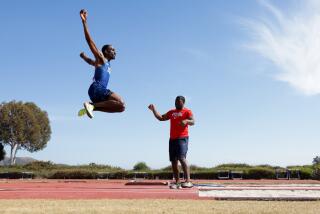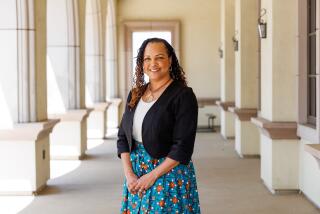Unity in Silence
- Share via
HUNTINGTON, W.Va. — Ida Dotson watched in amusement as her Marshall teammates discovered the pitfalls of communicating with the deaf.
The school’s first deaf athlete, Dotson took a seat along a railing after a recent basketball practice for a lesson in sign language. It was time for her teammates to step into her arena.
With a forward arm motion, palm up, they watched as interpreter Erin Kelsey signed the word for morning. She cautioned against brushing against their chins.
“You have to be careful when you do this, because it can be an ‘ugly’ sign,” Kelsey said.
Laughter erupted, and Dotson’s smile affirmed how easy it is to botch an otherwise simple task. It also showed the team’s enjoyment and dedication to making Dotson feel at ease in her new surroundings.
The preseason classes were about gaining social skills, not on-court communication. Dotson came to Marshall hoping to be just like any other student.
She “speaks” American Sign Language; English is her second language. So the players asked Kelsey, whom the university hired to be Dotson’s full-time interpreter, to help out for the long season ahead.
Little did they know it would be like learning the dictionary all over again.
On this day, they started with the alphabet, then moved to colors and times of day. Eventually, letters became drawn-out words, and words became choppy sentences.
One American Sign Language motion can mean many things, depending on the subject. For instance, the sign for aunt, apple and cool are similar.
“You’re afraid you’re going to call somebody’s mother a fat pig when you’re really trying to say she has a beautiful hat,” Kelsey said. “You’re afraid you’re going to say something insulting.”
Eventually, the players will stop being insecure about their signing ability, Kelsey said.
“Ida knows what you’re trying to say, or she’ll stop you and say, ‘What are you trying to say?’ Her temperament is such that she will work with you until you get your exact point across.”
Forward Catie Knable said, “It’s really brought our team closer together. Everybody wants to be able to communicate with her and speak her language.”
The next step, Dotson says, is to raise community awareness about the deaf.
“They need to catch up. They’re way far behind the times and we have many, many deaf here, but where are they?” Dotson said. “They tend to hide.
“Hearing people need to get to know that the deaf can do anything.”
Especially play basketball.
Dotson led Central Arizona Community College to a 30-4 record last season and a berth in the junior college national tournament. She averaged more than 15 points, four rebounds, three assists and three steals per game.
She was the state’s community college player of the year and helped a U.S. team win a gold medal last summer at the Deaf Olympics in Rome.
Dotson could have transferred to Gallaudet, a liberal arts school for hearing-impaired students in Washington, D.C., but she wanted to attend and play basketball at a Division I school.
She was steered to Marshall because first-year coach Royce Chadwick’s father was an assistant coach at Central Arizona. The teams share many of the same plays.
During her recruiting visit to Marshall, Dotson stressed she wanted to live like any other student yet have someone as a go-between.
The clincher was Marshall’s hiring of Kelsey. “If there was no interpreting, I wouldn’t be here,” Dotson said.
Kelsey goes with Dotson to her courses, practices and games, including on the road.
“Only when she gets in a jam, like you or I would get in a jam, then she asks for help,” Kelsey said. That includes trying to read the lips of people who talk fast and those with small lips, beards or mustaches.
Dotson uses an earpiece to pick up vibrations of sounds close by, such as a referee’s whistle.
During team meetings, Kelsey relays what Dotson’s coaches are saying. On the court, Chadwick uses hand signals to call offensive and defensive plays.
Her coaches consider her one of the fastest learners on the team.
“The gift she has is she plays so hard,” said assistant coach Roxanne White. “She’s so aware of everything that’s going on on the floor. If you demonstrate a drill to her once, she picks it up. It just doesn’t take long for her to do things right.”
Dotson, a guard, started each of Marshall’s two exhibition games. She led the team in scoring through the first four regular-season games, averaging 15 points.
The biggest task, Chadwick said, is getting Dotson’s teammates to keep up with her.
“She is way ahead of the learning curve with all of them,” he said. “She understands the game. We have a very good relationship. I can look at her, she can read my lips, and she basically already knows what I want her to do.”


